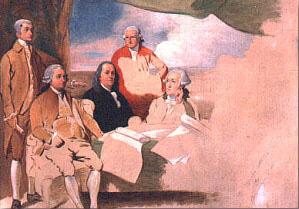Treaty of Paris (1783)
|
|
The Treaty of Paris of 1783, signed on September 3, 1783, formally ended the American Revolutionary War between the Kingdom of Great Britain and the Thirteen Colonies in North America who had rebelled against British rule in 1776. Great Britain signed ancillary treaties with France and Spain as the Treaties of Versailles of 1783.
The treaty is commonly referred to as the Second Treaty of Paris, the first being the Treaty of Paris of 1763. Several other treaties have also been made under this name. (See: Treaty of Paris.)
Summary
The treaty contained the following terms:
- Recognizing the thirteen colonies as the United States of America [Article 1];
- Establishing the boundaries between the United States and British North America [Article 2]; (for an account of a strange anomaly resulting from this part of the Treaty, see Northwest Angle)
- Granting fishing rights to United States fishermen in the Grand Banks, off the coast of Newfoundland and in the Gulf of Saint Lawrence [Article 3];
- Recognizing the lawful contracted debts to be paid to creditors on either side [Article 4];
- United States Congress will "earnestly recommend" to state legislatures to recognize the rightful owners of all confiscated lands "provide for the restitution of all estates, rights, and properties, which have been confiscated belonging to real British subjects." [never implemented, Article 5];
- United States Congress will prevent future confiscations [Article 6];
- Prisoners of war on both sides are to be released and all property left by British army in the United States unmolested (including "Negroes") [Article 7];
- Great Britain and the United States were each to be given perpetual access to the Mississippi River [Article 8];
- Territories captured by Americans subsequent to treaty will be returned without compensation [Article 9];
- Ratification of the treaty was to occur within six months from the signing by the contracting parties [Article 10]
The agreement
The treaty document was signed by David Hartley (a member of the British Parliament representing the British Monarch, George the Third), John Adams, Benjamin Franklin, and John Jay (representing the United States).
On September 3, Britain also signed separate agreements with France, Spain, and the Netherlands which had been negotiated earlier. In the treaty with Spain, Britain returned the colonies of East and West Florida without defining the northern boundary, resulting in disputed territory resolved with the Treaty of Madrid (1795). Spain also gained the island of Minorca and returned the Bahama Islands while Britain retained Gibraltar. The treaty with France mostly reinforced earlier treaties, guaranteeing fishing rights off Newfoundland.
The American Continental Congress ratified the treaty on January 14, 1784. Britain ratification occurred on April 9, 1784 and ratifications exchanged on May 12, 1784. Although Britain's ratification and the exchange were not within the six-month deadline specified by the treaty, this had no effect on the honoring of the treaty. The delay was partly caused by transportation difficulties.
External link
Template:Wikisourceparhe:חוזה_פאריס_(1783) nl:Vrede van Parijs (1783)

